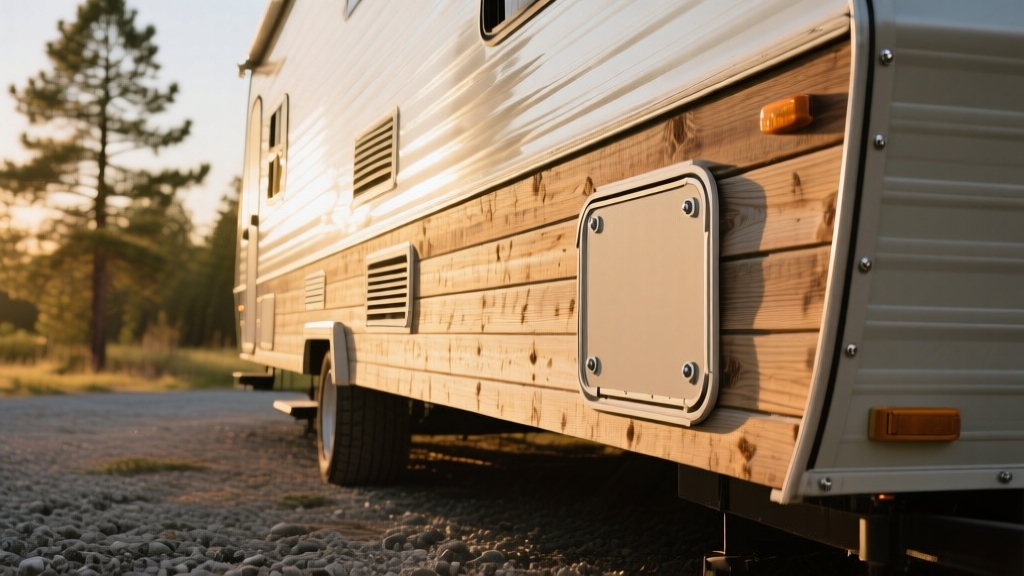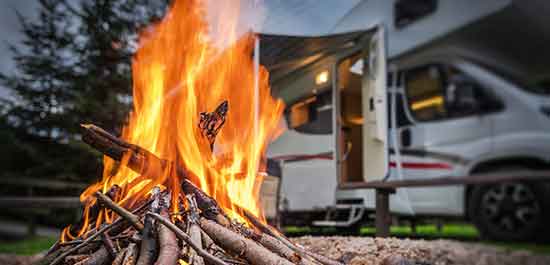You can improve your RV’s energy efficiency and protect plumbing from freezing by adding skirting made from durable vinyl, fabric, metal, or inflatable options. Measure carefully, choose materials that match your style, and consider layering foam boards with reflective insulation for extra warmth.
Installation is straightforward with adhesive hooks or zippered panels, and regular maintenance extends skirting life. These strategies boost comfort and lower heating costs. Explore how to customize and optimize your setup for year-round protection.
Key Takeaways
- Use durable vinyl skirting with colorfast patterns and quilting for both insulation and stylish exterior matching.
- Combine foam insulation boards with Reflectix inside skirting for enhanced thermal protection and energy savings.
- Consider inflatable or fabric skirting for easy setup, portability, and frequent RV moves.
- Measure perimeter and ground clearance precisely, including slide-outs and obstacles, for a snug, draft-free fit.
- Secure skirting with adhesive hooks, grommets, and stakes, and maintain by resealing seams and cleaning regularly.
Benefits of Installing RV Skirting
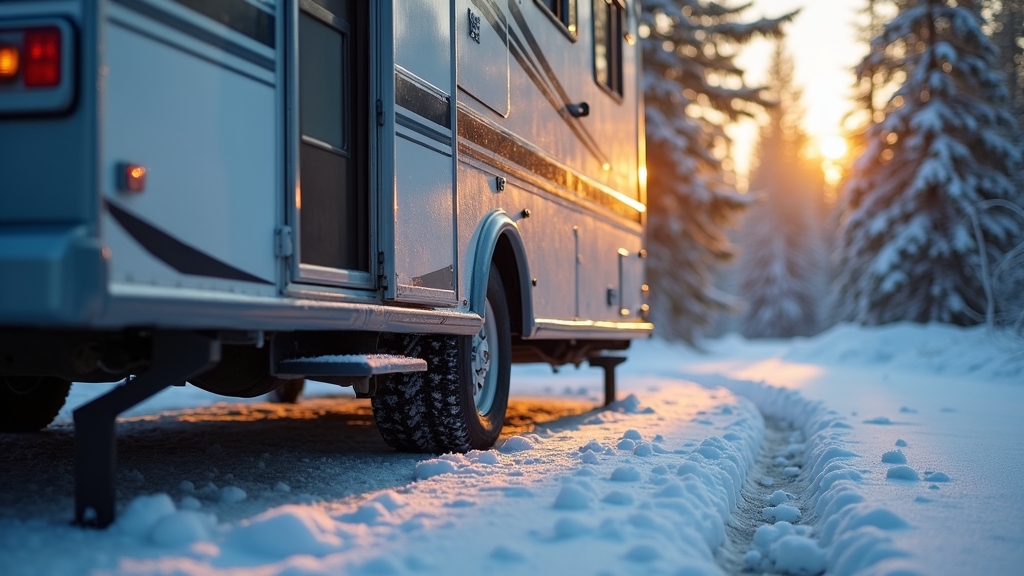
When you install RV skirting, you not only boost your rig’s energy efficiency but also enhance your overall comfort and protect essential systems.
Skirting reduces heat loss from the undercarriage in cold weather, cutting propane and electricity use for heating. In hot weather, it blocks heat transfer from the ground, keeping your living space cooler and easing HVAC strain. This stable temperature control lowers energy bills and extends HVAC lifespan.
Additionally, skirting insulates floors, minimizes drafts, and prevents moisture buildup, making your RV more livable in extreme weather. Proper insulation and temperature control are key factors in energy efficiency.
It also shields plumbing from freezing, reducing costly repairs, and protects your rig from wind, rain, and pests. By enclosing the underside, skirting creates a barrier that helps prevent plumbing system freezing, which is crucial during freezing temperatures.
Plus, it offers convenient storage space and helps maintain your RV’s appearance and value. Durable construction materials ensure the skirting lasts through multiple seasons while maintaining performance.
Different Materials for RV Skirting
Choosing the right material for your RV skirting can make a big difference in durability, insulation, and ease of use.
Vinyl skirting offers a durable, weather-resistant option with a polished look. However, it can be pricier and usually requires custom fitting. It helps maintain interior warmth by preventing cold air circulation under the RV.
Fabric skirting, like canvas or nylon, is budget-friendly and easy to install. It’s perfect if you move frequently, but it provides less insulation.
For longer stays, plywood skirting gives solid protection and good insulation. However, it’s heavier and less portable.
Inflatable skirting is a modern, space-saving choice that’s simple to set up and remove. It’s ideal for travelers on the go.
Foam insulation boards offer excellent thermal protection and are great for DIY projects. They’re especially effective when combined with other materials.
Select what fits your needs best!
How to Measure Your RV for Skirting?
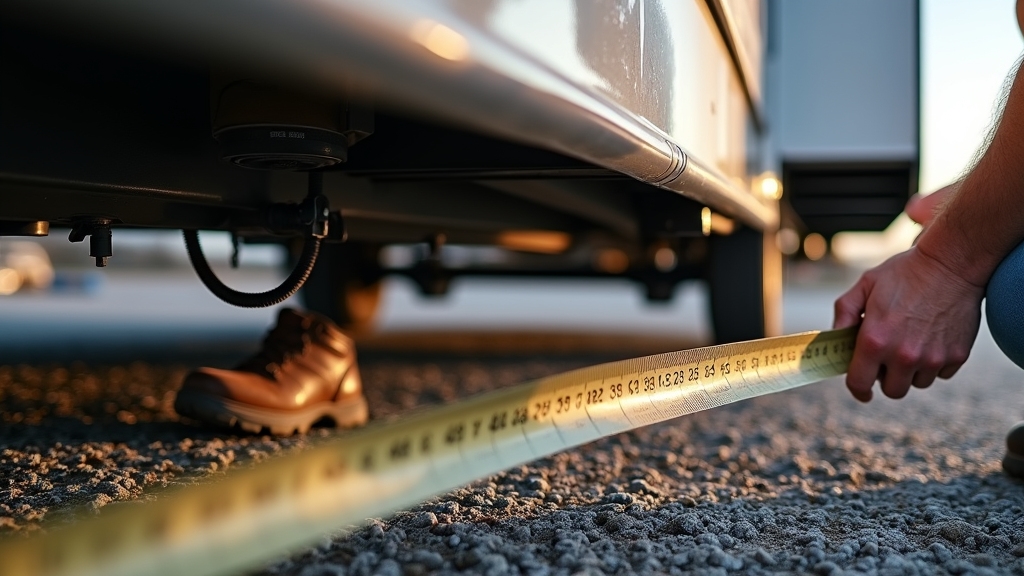
Accurately measuring your RV is crucial to guarantee the skirting fits perfectly and provides effective insulation.
Start by measuring the full perimeter, including slide-outs extended. Use a flexible tape to follow contours closely. This ensures compatibility with the tire size specifications necessary for maintaining trailer balance.
Don’t forget to add extra length for overlaps and mark any access points. Proper measurements help to prevent cold air infiltration, maintaining warmer interior temperatures.
Measure ground clearance at several spots, adding 6-12 inches for securing the skirting to the RV and ground.
Note obstacles like wheel wells or stairs for custom fitting. Use a notepad or device to record and verify measurements.
| Measurement Aspect | Key Tip | Purpose |
|---|---|---|
| Perimeter | Include slide-outs | Accurate total length |
| Height | Add 6-12 inches | Secure and seal |
| Ground Clearance | Measure multiple points | Account for uneven terrain |
| Access Points/Obstacles | Mark precisely | Ensure proper cutouts |
DIY Vinyl Skirting Installation Tips
How do you guarantee your vinyl skirting stays secure and looks great throughout the seasons?
Start by folding the top edge about 4 inches for strength and neatness. Clean your RV surface with alcohol before applying adhesive hooks or 3M sticky studs every 6-10 inches. Reinforce with screws for durability.
Install in temperatures above 60°F and dry conditions, allowing adhesive studs to set 24 hours before attaching panels. Using vinyl with grommets simplifies hanging and ensures a sturdy installation. Roll out the vinyl first, mark cut lines, and leave ½ to ¾-inch clearance near fasteners to prevent tearing.
Use snap-buttons or Velcro to seal overlaps and avoid blocking vents. Finish by securing the bottom with trim or spikes to reduce wind movement.
Using Foam Board for Insulated Skirting
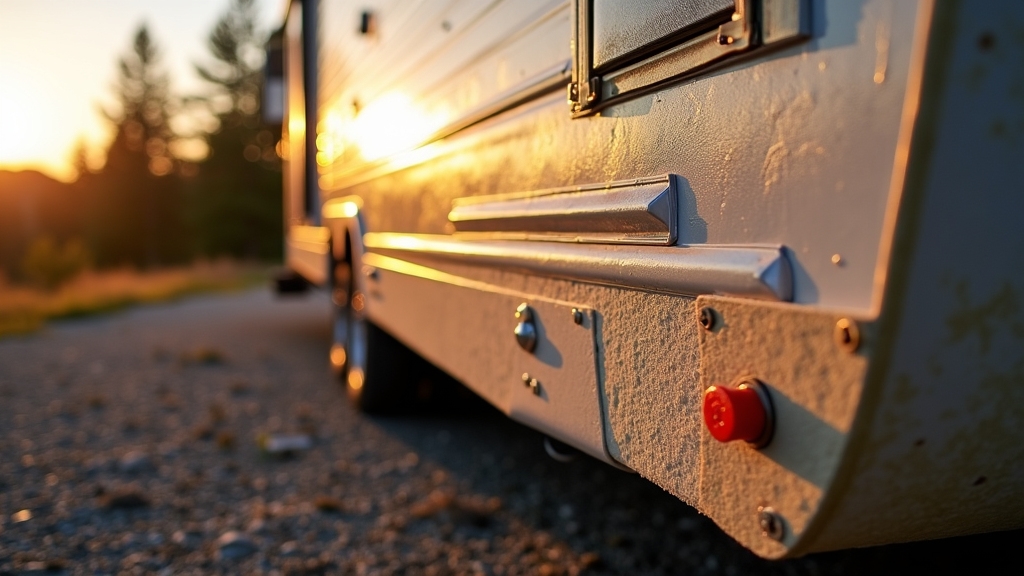
While foam board insulation offers an affordable and effective way to keep your RV warmer during colder months, selecting the right type and thickness is essential for superior performance.
Choose high-density extruded polystyrene (XPS) or expanded polystyrene (EPS) boards, typically 1–2 inches thick with R-values between R-5 and R-7.5. White-faced or foil-faced boards add durability and a clean look.
Measure carefully, cut precisely, and seal seams with foil tape to minimize drafts. Anchor boards securely to withstand wind. Use foil HVAC tape for attaching foam to the camper and white duct tape for joining foam pieces at seams to ensure durable installation and easy future adjustments materials and attachment.
| Board Type | Thickness | R-Value Range |
|---|---|---|
| XPS | 1-2 in | R-5 to R-7.5 |
| EPS | 1-2 in | R-5 to R-7.0 |
| White or Foil Faced | N/A | Adds durability |
This method is cost-effective and reusable. Check campground rules first.
Creative Fabric and Canvas Skirting Ideas
When it comes to RV skirting, you definitely want something that can stand up to the elements, right? That’s why going for durable canvas materials is a smart choice. They offer a nice balance between being breathable and weather-resistant.
Canvas or heavy fabric skirting is lightweight and easy to work with, making DIY installation simpler. Choosing materials with waterproof and UV-resistant properties ensures your skirting will last through diverse weather conditions.
Plus, you can find some great custom fabric patterns out there that really let you put your personal touch on your setup.
Imagine being able to have skirting that not only does its job but also looks fantastic! With the right choices, you can achieve that perfect blend of toughness and visual appeal.
Durable Canvas Material Choices
Because your RV skirting needs to withstand harsh weather and frequent use, selecting durable canvas materials is essential. Heavy-duty 18-ounce vinyl coated polyester, like Coverene, offers excellent tensile strength and abrasion resistance. Choosing materials with the right load capacity ensures your skirting maintains strength under stress.
Marine vinyl stands out for all-season durability, resisting rain, snow, and UV damage. Diamond-Weave™ fabrics keep their integrity even in temperatures as low as -40°F, perfect for cold climates.
Military-grade PVC coated canvas, often used in inflatable skirts, protects without drilling into your RV, preserving its structure. These materials also help reduce moisture intrusion and heat loss, boosting insulation efficiency. Insulating RV with canvas skirting can reduce propane costs by up to 40%, making these material choices not only durable but energy-efficient.
Lightweight yet tough, they fold easily for storage and require minimal maintenance. Choosing the right durable canvas ensures your skirting stays functional, energy-efficient, and resilient through every season.
Custom Fabric Patterns
Durable canvas materials set the foundation for effective RV skirting, but customizing fabric patterns brings both function and style to your setup. You can choose from 35+ colorfast vinyl options to match your RV’s exterior or personal taste.
Our skirting products feature a diamond weave pattern that enhances both aesthetic appeal and durability. Proper airflow considerations, similar to those used in enhancing RV fridge efficiency, can also improve ventilation beneath your skirting through optimized airflow design.
Quilted diamond patterns add texture, while contrasting panel colors create eye-catching framed effects. Functional features like panelized sections with zippers or Velcro simplify installation and allow for vents or storage cutouts.
| Feature | Benefit |
|---|---|
| Quilted diamond pattern | Adds texture and visual interest |
| Multi-color panels | Customizes look to your style |
| Zippered panels | Easy assembly and access |
Tailor your skirting for aesthetics and adaptability without sacrificing durability or protection.
Metal and Inflatable Skirting Options
When you go for metal skirting, you’re really investing in something that’s built to last. It offers solid protection against harsh weather, pesky pests, and even impacts from accidental bumps or scrapes. It’s like having a sturdy shield around your RV! Metal skirting can be a good choice for those who want a durable barrier that helps reduce heating expenses during cold winter months.
Now, if you’re looking for something a bit lighter and easier to manage, inflatable skirting might be the way to go. It’s super portable, which makes it a breeze to set up and take down—perfect for those temporary situations.
Metal Skirting Benefits
If you want sturdy protection for your RV’s undercarriage, metal skirting offers a reliable solution that stands up to harsh weather and pests. Made from durable aluminum or steel, it shields your RV from snow, ice, and unwanted rodents.
You’ll appreciate its longevity; metal skirting lasts longer than vinyl or fabric options with proper care. However, it is prone to rust, so repainting when paint peels is necessary to combat corrosion. Choosing the right protective coating can significantly extend the life of metal skirting by preventing rust and wear.
Plus, it adds a sleek, professional appearance and enhances security by preventing unauthorized access underneath.
Though installation requires more skill and can be pricier upfront, the durability often makes it cost-effective over time. Considering maintenance and weather resistance is key when evaluating long-term investments for RV protection.
Just remember to keep it clean and inspect it regularly to maintain its protective qualities.
Choosing metal skirting means you’re investing in strong, weather-resistant coverage that keeps your RV safe and looking sharp.
Inflatable Skirting Features
While metal skirting offers robust protection and a sleek look, inflatable skirting presents a flexible, innovative alternative that’s gaining popularity among RV owners. Inflatable skirting is also valued for its easy installation and adaptability, making it a convenient choice for many.
Made from military-grade PVC tarpaulin, inflatable skirts use air-filled tubes around your RV’s perimeter to create an insulating barrier that traps heat or cool air. This improves energy efficiency and protects pipes. The tubes feature welded D rings and tire wedges for secure sealing and added protection, enhancing overall durability and performance. durable construction
You’ll appreciate the easy, no-drill installation and quick 20-minute setup, plus the ability to deflate and store it compactly. Inflatable skirting adapts to various RV sizes, stays securely in place in wind or snow, and shields your undercarriage from damage.
Though it may not seal as tightly as metal, its portability and year-round weather resistance make it a practical choice for enhancing comfort and reducing heating costs.
Cost Considerations for RV Skirting Projects
Because RV skirting involves various materials and installation choices, understanding the associated costs upfront can help you budget effectively. Choosing materials with a proper temperature range sensitivity can also impact long-term durability.
Foam board offers a low-cost DIY option, while vinyl skirting ranges from about $400 to $1,200 for smaller units.
Metal skirting costs more, $800 to $3,000, depending on size and type.
Ready-made kits like EZ Snap start around $840 and provide a no-drill install option using 3M VHB adhesive.
Professional installation can push expenses beyond $2,700, including possible travel fees.
DIY installs save labor costs but require time and effort.
Durable materials like vinyl and metal have higher upfront prices but reduce long-term replacements.
Custom fits, complex shapes, and extra accessories increase costs.
Financing plans are sometimes available, letting you spread payments.
Maintenance Tips to Extend Skirting Life
Maintaining your RV skirting regularly guarantees it stays durable and effective against weather and pests.
Begin by inspecting seams and edges for gaps or damage, sealing them promptly to prevent moisture intrusion. Proper maintenance is just as crucial as paying attention to tire maintenance practices for overall RV safety.
Clean your skirting and the surrounding area often to avoid debris buildup that can trap moisture. Using gray duct tape to reseal any small tears or joints can significantly improve insulation efficiency.
Check staples and fasteners to ensure they’re secure and rust-free, replacing any that show wear.
Tailor your maintenance to the season: seal gaps and tighten fittings in fall, and remove winter skirting with thorough cleaning come spring.
Use breathable materials and manage trim around jacks for proper drainage, preventing rot and rust.
With these simple, routine steps, you’ll extend your skirting’s lifespan and keep your RV well-protected year-round.
Combining Skirting With Additional Insulation Methods
When you combine skirting with additional insulation methods, you considerably boost your RV’s ability to retain heat and protect against harsh weather.
For example, layering foam board skirting with Reflectix reflective insulation enhances both thermal resistance and radiant heat reflection.
Make sure to seal all joints using weather stripping or foam blocks to minimize drafts and air leaks.
Adding a windbreak, like plywood or vinyl, shields the insulation from wind damage and helps reduce noise and vibrations caused by wind exposure.
For extreme cold, inflatable skirting paired with foam or reflective layers traps warm air effectively, especially when used with thermostatic heaters.
Secure your skirting firmly with stakes or adhesive strips to prevent movement.
This multi-layer approach balances durability, cost, and efficiency, giving you a cozy, protected RV during chilly months. Using robust skirting materials helps prevent costly winter damage and prolongs your RV’s lifespan.
Frequently Asked Questions
Can RV Skirting Improve Resale Value of My RV?
Yes, adding RV skirting can improve your RV’s resale value.
It protects your rig from harsh weather and reduces wear, keeping it in better condition.
Skirting also provides insulation, making your RV more appealing to buyers who want comfort in colder climates.
Plus, a neat, customized skirting setup enhances your RV’s overall look.
How Does RV Skirting Affect Ventilation Under the RV?
Think of your RV’s underside as a hidden room needing fresh air to breathe.
Skirting affects ventilation by controlling airflow beneath your RV. Without vents, moisture and gases get trapped, causing mold, rust, and damage.
You’ll want skirting with well-placed vents to let air circulate. This keeps humidity low and prevents toxic buildup.
This balance protects your RV’s structure and plumbing, ensuring your cozy space stays healthy and damage-free.
Are There Eco-Friendly Materials for RV Skirting?
Yes, you can use eco-friendly materials for RV skirting.
Reclaimed billboard vinyl is a durable, recycled option that keeps waste out of landfills.
Heavy-duty tarps made from recycled plastics also work but may wear faster.
For insulation, look for foam boards with recycled content.
Natural materials like straw bales are biodegradable but less durable.
Using reusable anchoring like sand or water bags helps reduce plastic waste too.
Can RV Skirting Help Reduce Noise From Wind or Wildlife?
Absolutely, RV skirting can turn your noisy ride into a quiet sanctuary!
It blocks wind from rushing underneath, slashing that annoying whooshing sound.
Plus, it keeps critters from scurrying below, so you won’t hear scratching or chewing noises.
If you choose insulated or inflatable skirting, you’ll also trap sound vibrations better.
What Seasonal Accessories Complement RV Skirting During Winter?
You’ll want to pair your skirting with spray foam or insulating tapes to seal gaps, plus reflective insulation panels for extra warmth.
Adding door insulation kits and window insulation film helps block drafts inside.
Portable heaters and heated water hoses prevent freezing, while tank heaters protect plumbing.
Don’t forget moisture absorbers to keep humidity down.
These accessories work together to keep your RV cozy and safe all winter long.
From Vinyl to Metal: Choose the Right Skirting for You
Installing RV skirting isn’t just about keeping things neat. It’s your RV’s way of staying cozy and protected when the weather isn’t cooperating. Whether you choose vinyl, foam board, or metal, a little effort goes a long way in preserving comfort and cutting energy costs.
By combining skirting with smart insulation, you’re giving your RV a well-deserved layer of care. This turns chilly nights into opportunities for warmth and peace of mind.

